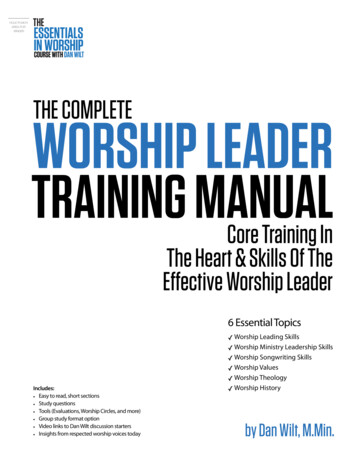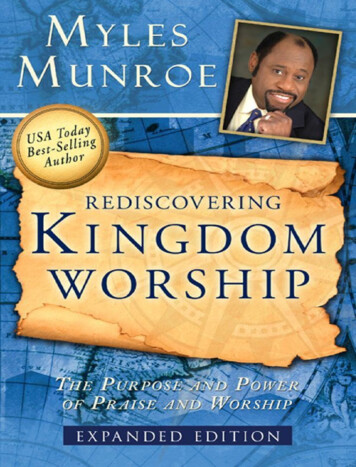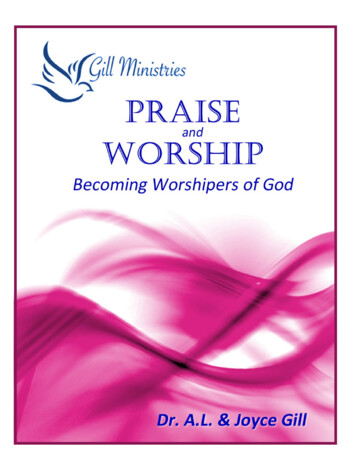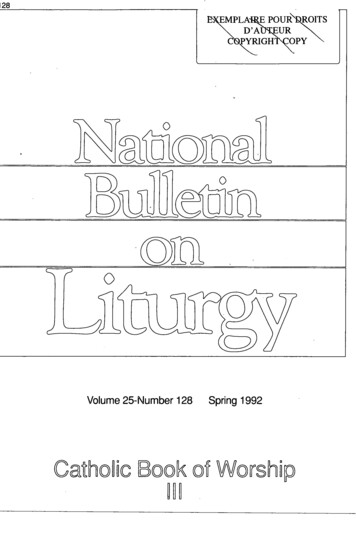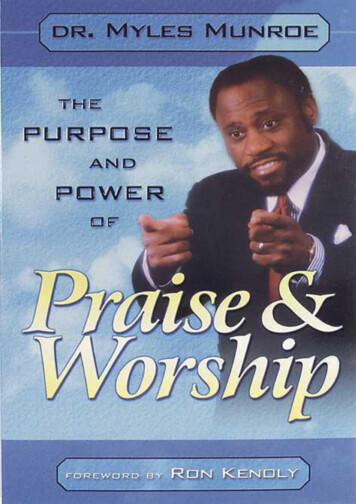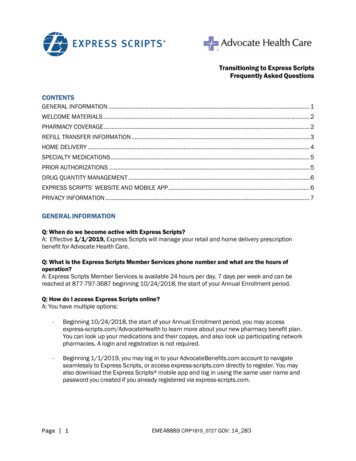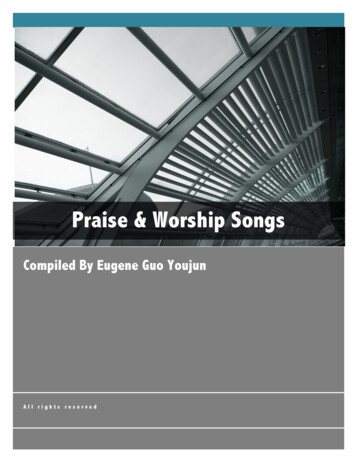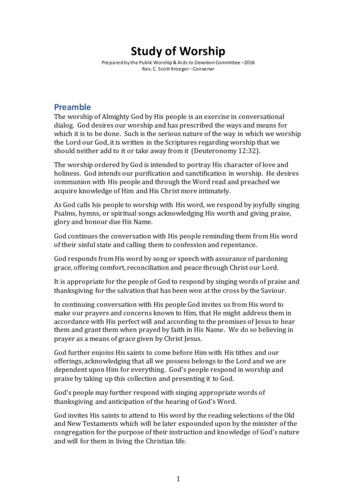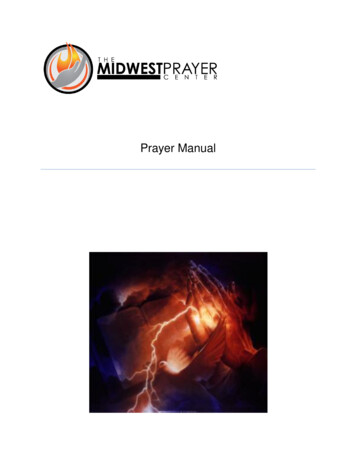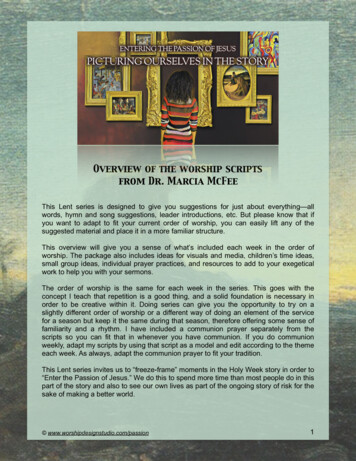
Transcription
Overview of the worship scriptsfrom Dr. Marcia McFeeThis Lent series is designed to give you suggestions for just about everything—allwords, hymn and song suggestions, leader introductions, etc. But please know that ifyou want to adapt to fit your current order of worship, you can easily lift any of thesuggested material and place it in a more familiar structure.This overview will give you a sense of what’s included each week in the order ofworship. The package also includes ideas for visuals and media, children’s time ideas,small group ideas, individual prayer practices, and resources to add to your exegeticalwork to help you with your sermons.The order of worship is the same for each week in the series. This goes with theconcept I teach that repetition is a good thing, and a solid foundation is necessary inorder to be creative within it. Doing series can give you the opportunity to try on aslightly different order of worship or a different way of doing an element of the servicefor a season but keep it the same during that season, therefore offering some sense offamiliarity and a rhythm. I have included a communion prayer separately from thescripts so you can fit that in whenever you have communion. If you do communionweekly, adapt my scripts by using that script as a model and edit according to the themeeach week. As always, adapt the communion prayer to fit your tradition.This Lent series invites us to “freeze-frame” moments in the Holy Week story in order to“Enter the Passion of Jesus.” We do this to spend more time than most people do in thispart of the story and also to see our own lives as part of the ongoing story of risk for thesake of making a better world. www.worshipdesignstudio.com/passion!1
The “Anchor Image” (main metaphor) for the series is anantique art frame. As I worked with the book that was theinspiration for this series (Amy-Jill Levine’s Entering thePassion of Jesus: A Beginners Guide to Holy Week), I wasstruck with how this Jewish New Testament scholar washelping us dive more deeply into each scene, “framing” themoment with the historical and cultural context. Theartwork on the cover of the book inspired me to create away to incorporate the amazing collection of artwork at theVanderbilt Lectionary website, which I have enjoyed formany years (special thanks to Anne Richardson, SpecialProjects Librarian at the Vanderbilt Divinity Library, for herassistance). I was also aware that they had recentlyadded more contemporary works of art (aided by myfriend, Dr. Kathy Black) by artists from a diversity of ethnicbackgrounds. I am excited to introduce you to thecollection if you do not already know about it. Throughoutthe season, we will “frame” our own current events andstories so that we might dedicate ourselves again to ourwork as disciples of Jesus.My prayer is that you and your congregation will learn much from Levine’s resource aswell as from your own experience of reframing life along the lines of the Divine Artist.Peace & Passion,Dr. Marcia McFee www.worshipdesignstudio.com/passion!2
A note from Marcia about the visuals for this series:My initial thought was that “artwork” was the “anchor image” (my term forthe main metaphor). But when I went to the Legion of Honor Museum inSan Francisco for inspiration, what struck me was the frames that were thecontainers of the artwork. This is really what we are doing as we “enter thepassion”–creating a “framework” to experience the story anew. So here is apiece I wrote while at the museum that gets at the underlying spiritualityand direction for the series and why “frames” are now a main metaphor forme as well as what we put into the frame:“Framing”I sit in a room among the greats:rodinmonetrenoirseurateach in their own way trying to grasp andcapture a momentthe beauty of lifethe sweetness and colorthe movement and stillnessthe delicate nature of existenceand in their attempts we see creation and humanityin stark reliefin yearningin ecstasybut only impressionsand interpretationsthat is what we do as we enter the story of Jesus’ passionwe come to it with our own eyes, our own humanity, our own experiencethat gets all wrapped up in our interpretation www.worshipdesignstudio.com/passion!3
and yet isn’t that how faith works?isn’t that how meaning is made?for in the end objectivity is elusiveand all we can know is what we see, how we see itbut it is in the looking that we knowwe cometo greater awarenessunderstandinginsightand ultimately compassionfor other’s place in the story and our ownso let us enter the passion of Jesuslet us spend some timelet us freeze frame a momentso we might dwell become not just story tellers but story dwellerslook deeply and longtake our timea week becomes a seasona week becomes a lifetimea week becomes two millenniaA week becomes eternitywe’ll put a frame around itwe’ll section off a scenewe’ll look long into a faceto see what we can seeto know what we can knowto touch our own heartsas is the hope of every artistfor those of us who gazethe Divine Artist offers us such poignant beautyeach dayin our own storiesin the stories around usin the heartbreak and pain and joy and awe www.worshipdesignstudio.com/passion!4
of a simple moment turned significantthat’s what happens when we put a frame around itwe zoom infor an existential close-upand search for cluesfor living this life with moreattentionintentionI pray for the framesto surround the moments of my lifethat I dare not miss— Marcia McFee www.worshipdesignstudio.com/passion!5
A description of the flow and order of the weekly worship experiencesA note about the section titles: One of the ways I like to be creative in worship design isto use wording for the sections of worship that add to the theological understanding ofthe series theme. I have done this for the four-fold pattern of worship for this series(“Entering the Story” for Gathering; “Getting Perspective” for Proclaiming; “Zooming In”for Responding; and “Entering the World’s Story” for Sending Forth).Enteringthe StoryMusic for Gathering and AnnouncementsThe Prelude is up to your musicians. And we suggest doing your announcements in thebeginning so that once you “cross the threshold,” you get to stay in the feeling of theritual itself. If you want to see my suggestions about announcements, see my blog postabout that topic HERE.Crossing the ThresholdThis is what I call a “threshold moment.” This concept that I teach introduces people tothe journey and the theme of the day at the beginning of the service so that everythingin the worship experience is seen through that lens. This is also why I call my series“worship series” rather than “sermon series.” I am an ardent advocate that all theworship arts contribute to the main message, and helping people to enter that messageat the beginning of the ritual in a focused way helps us to be “immersed” in the world ofthe story from the “get-go.”I’ve written a musical refrain for this series that has two versions (the “I/You” and “We”versions). This refrain will be repeated from week to week—what I call a “thread” in myseries design methodology. I’m hoping the opening of worship will feel like the beginningof a musical theater experience (part of my past life professional background) in whichwe are invited to “enter the story.”Here is an example: www.worshipdesignstudio.com/passion!6
[soloist and/or choir sings as the artwork of the Palm Sunday parade is projected]EnterCome enter the storyEnter the place you belongNot just looking onFor this is your storyEnter the story[musical underscoring continues as the Pastor says ]Pastor: Jesus’ ride into Jerusalem at the beginning of Holy Week was full of risk.Rather than a nice impromptu celebration, it can be seen for the carefullyplanned and significantly symbolic event that would rub those in power thewrong way. In a moment already filled with tension, this “victory parade” hadmany implications, and as we know, many consequences. We will stop theaction just at the beginning of the parade to take stock of all the players,including the role the city itself plays full of pilgrims for the Passover.[the congregation joins in the theme song with the soloist and choir]EnterEnter the passionEnter the place we belongNot just looking onFor this is our passionEnter the passionPrayer of ConfessionThis series includes a Prayer of Confession during this beginning portion of the service.It helps us to continue to enter the Passion story by casting us in the role of the crowdand making an analogy with our role in today’s society. Each week’s prayer is unique tothat story but always ends in another verbal “thread”:You entered our story through Jesus,now help us to enter fully into the storyof your kin-dom on earth as it is in heaven. Amen.Opening Responsive Hymn/SongAs usual, we have chosen hymns (for more “traditional/classic” worship) and songs (formore “modern/contemporary” worship) as suggestions. But you can also feel free toadapt our suggestions, using something more beloved by your congregation if youchoose. See the Music Document for a guide to our acronyms in the script. www.worshipdesignstudio.com/passion!7
For this series, I have placed this first hymn/song in between the Confession andAssurance. This is why I call it an “Opening Responsive Hymn/Song.” My hope is thatthe selections help move us more fully into the “picture” and receive the assurance andpeace just after the singing.Assurance of Pardon and Entering the Peace of ChristEach week, the words of assurance are spoken directly after the singing, and they endwith this line: “Let us enter the passion of Christ, and pass the peace of Christ with eachother.” I’ll let you in on how this line relates to my personal life. Many years ago, I begansigning all my communication “Peace and Passion” and using this phrase in mybenedictions in worship. “Passion” is the liturgical/theological term for Holy Week but Ialso think that being “passionate” as Jesus was passionate about people (especially the“least of these”) is as necessary as having access to the “peace” of Christ in living ourlives as disciples. As Amy-Jill Levine says in her book, “The Passion narrative asksmuch of us, and it also, through Jesus’ example, gives us the knowledge that we can dowhat we are asked, and the assurance that we will succeed.”GettingPerspectiveTelling the Story: Through a Child’s Eyes(Children’s Time with the Gospel)Once again we have wonderful scripts for children’s time written by WDS Associate,Mark Burrows! For this series, he created active engagement for children with the actualGospel texts related to the story of each week. Because the Gospel scripture text isincluded in this time, it felt unnecessary to repeat it with a “typical” have-an-adult-standand-read version afterwards. So this is where the Gospel text will be encountered. I lovethis because I believe that children’s time can be a part of the liturgy, not simply an“aside.” If you do not have a time with children in your worship, you can delete this andput a Gospel reading in after the other reading (see below).I’ve chosen one of my childhood favorite hymns as the musical transition to thechildren’s time: “I Love to Tell the Story.” We are both story-tellers and story-dwellers! www.worshipdesignstudio.com/passion!8
Listening for the Story(Anthem with Scripture)Each week I have chosen an accompanying scripture reading that figures into theoverall context of the Holy Week moment. In most cases, the selection came from AmyJill Levine’s having mentioned it in her corresponding chapter. I have written anintroduction to the passage for the reader to say just before the reading that connectsthe scripture to the Gospel story.I have made suggestions of anthems (or songs for bands) that relate to the Gospel storyor the accompanying text that is read for each week. As always, if what I have chosendoesn’t feel right for your musicians, have them search for selections on the scripture(s)that would be more appropriate for them. Note that I suggest the musicians are in placeand ready to go as soon as the scripture reading concludes so that it feels “as a wholepiece” of listening—entering—more deeply to the Passion story.Dwelling in the Story(A kind of “midrash” based on the artwork)When the anthem/song selection finishes, a group of dramatists gets into place, holdingthe pose of the featured painting for the week. Most of the dramatists will simply holdthe pose, but one of the characters comes out from the tableau to do a monologue Iwrote from my imaginative perspective of that face in the painting. This is a kind of“midrash” exercise—a name for an ancient Jewish practice of interpreting holy texts. Iuse this term (described for us in Levine’s book) as an analogy of diving deeper into theartwork and combining it with what we might know or imagine of the circumstances ofthat day. See more about this in the Small Group suggestions document download.If you do not have people who can do this dramatic interpretation, there are many waysto adapt it, having one voice simply read it or incorporating it into the sermon.SermonThe biggest challenge about sermons for this series will be that you have so muchfodder from Levine’s book, the DVD, and our sermon notes! Your main job will be todetermine which aspects of the reflections on the events of Holy Week are mostpoignant, meaningful, and challenging perhaps, for your congregation. The beautifulthing about having a small group study alongside a worship series is that you don’t haveto do it all in the sermon. My suggestion is that you hold your small group bookdiscussions in the week after the chapter is highlighted in worship. This way you areproviding them a jumping off point for an even deeper dive during the week.I am hoping that you provide people an opportunity to “de-brief” with each other at theend of the sermon. Where do they see themselves in the story/artwork? What mightthey have been thinking and feeling if they had been there in that moment? www.worshipdesignstudio.com/passion!9
ZoomingInThe Body of Christ Prays(Prayers of the People)Prayer time features the “thread” song, “Turn Your Eyes Upon Jesus.” Looking deeplyinto the Holy Week story through Lent invites us to look fully into the life of Jesus, butalso to see Jesus in the work for justice around us even now. Prayers are structured insuch a way that you can use even more of the artwork from the Vanderbilt DigitalLibrary if you so choose, as well as create a collection of images that relate to ourmodern-day work for a better world in which all can thrive. Then it goes on to offer atime for lifting up those in our communities and lives who need our prayers.A Time of Offering Ourselves(Communion and/or Offering/Doxology)As I do for all my fully-scripted series, I have written a Communion prayer that draws inimagery from the series. You will insert it whenever your community typically practicescommunion, whether that be monthly or weekly. You are encouraged to adapt my wordsto fit your tradition’s practice and to fit the particular Sunday(s) in which it falls in order toconnect even more powerfully to the story. If you will do a separate offering, pleaseinsert this in a way familiar to your congregation. I’ve used the tune for “Turn Your EyesUpon Jesus” for the Communion Setting, and the Sanctus could work well for aDoxology if you are not using it in communion that week.We have made a suggestion of utilizing the photographs/artwork of the congregationduring the taking of offering or receiving communion (see note about this in the“Benediction” section below). www.worshipdesignstudio.com/passion!10
Entering theWorld’s StoryClosing Hymn/SongAgain, we have offered a couple of choices from different styles of worship music, butplease adapt as necessary for your context.BenedictionThroughout this series, you have the opportunity to get creative with the idea of“framing” life. We have made a lot of suggestions in our Visual and Media documentdownload about great mobile apps that create paint-like versions of photographs at thetouch of a finger. I have found that when I do this, I not only capture a moment of life,but the added color and brushstroke treatments create a way of seeing that moment’sbeauty in a deeper way. This is exactly what we are trying to do with this worship seriesas we “Enter the Passion of Jesus” more deeply and see there the beauty of life’ssorrows and joys. I have written example verbiage of invitation for your congregation toget into some photo-taking during the week or even of themselves and each other afterworship. It will be wonderful if these images can be incorporated throughout the series.The Benediction words are from a poem I wrote while sitting at a museum when I firststarted writing this series. See my post about that HERE.“This season we are putting a frame around a bit of lifewe section off a scene,we look long into a face,to see what we can see,to know what we can know ”Postlude www.worshipdesignstudio.com/passion!11
I hope this helps you get an at-a-glance feel for the scripts!See the synopses for every worship experience in the series HEREIf you haven’t purchased the series yet (free to WDS members), click HEREIf you’d like to get access to ALL our series, check out a Worship Design Studiosubscription HEREwww.worshipdesignstudio.com/passionPhoto credit on p. 5: Swanson, John August. Kiss of Judas, from Art in the ChristianTradition, a project of the Vanderbilt Divinity Library, Nashville, TN. .pl?RC 56551. Original source:www.johnaugustswanson.com - copyright 2008 by John August Swanson. www.worshipdesignstudio.com/passion!12
For this is our passion Enter the passion Prayer of Confession This series includes a Prayer of Confession during this beginning portion of the service. It helps us to continue to enter the Passion story by casting us in the role of the crowd and making an analogy with our role in today’s
